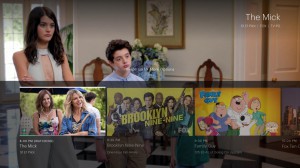The rise of the skinny bundle
The US is experiencing an influx of slimmed-down, OTT-delivered cable offerings. But how is this trend affecting the pay TV industry and does this latest development translate over to the European market? Andy Fry reports.
For decades, the global pay TV business has been dominated by cable and satellite platforms offering large bundles of thematic channels. But the arrival of SVOD services like Netflix, Hulu and Amazon was the first indication that the traditional way of packaging content might be under threat. Now more upheaval in the pay TV market could be on the horizon thanks to the introduction of so-called ‘skinny bundles’.
As the name suggests, skinny bundles are services that offer a lower number of channels than a traditional pay TV platform at a reduced price. Streamed over the internet, they are targeted at people who are unhappy paying for hundreds of channels they never watch but feel that on-demand services like Netflix don’t provide a sufficiently rounded TV entertainment experience.
The existence of this middle ground is evident in research data. In October 2016, for example, a survey from US strategic consultancy Activate reported that 61% of people without pay TV gave their reasons for not subscribing as “not worth the money”, “can’t afford it” or “too many channels”. At the other end of the spectrum, GfK has found that those without pay TV, typically younger audiences, miss the buzz of live sport and the ability to channel surf. GfK senior vice-president of consumer insights and trends, Karen Ramspacher told DTVE that: “There is interest among younger audiences in skinny bundles, though it depends of course on what channels are included in the package on offer.”
Right now, the market that best encapsulates the skinny bundle debate is the US – where a number of companies have already launched new services or are about to do so. First into the fray were Sony’s PlayStation Vue and Sling TV, a low-cost offering from DTH pay TV operator Dish that already has around one million customers. Coming soon is a skinny bundle offering from Hulu – with Apple, Amazon and YouTube also circling the sector. Also significant is DirecTV’s new skinny bundle offering, DirecTV Now, which joined the market in late 2016.
There are two keys reason why all of this is happening now in the US. The first is that broadband is fast enough and widely[icitspot id=”682162″ template=”box-story”] penetrated enough to make the delivery of multiple channels via OTT a viable proposition. The second is that there is a meaningful gap to aim at. Services like Netflix are typically sub-US$10 per-month, while traditional cable pay TV packages often run to more than US$100 when the cost of set-top box rental is included.
Underlining the point, Sling TV’s offering starts at US$20 (e19) per-month for a bundle of around 30 live TV channels, including A&E, AMC, ESPN, History Channel and Disney Channel. The highest price Sling TV goes up to is US$40 per-month, which is still a significant discount against what legacy pay TV packages cost in the US. It’s a similar story with Hulu’s planned package. Speaking at the Consumer Electronics Show in Las Vegas in January, Hulu CEO Mike Hopkins said the company’s proposed service will cost under US$40 per month and will include its existing US$8 SVOD package. Deals have been done with pay TV channel operators such as Walt Disney, 21st Century Fox, Time Warner’s Turner and CBS.
Incumbent experiments
As with SVOD, the skinny bundle play is a potentially disruptive innovation. But it would be wrong to assume that ‘disruptors’ are going to win the battle for consumers. Sling TV belongs to an established DTH operator while Hulu’s shareholders are NBC Universal, Fox Entertainment, Disney-ABC and Turner. NBCU, which owns 30% of Hulu, is itself a subsidiary of leading US cable operator Comcast. AT&T-owned DTH platform DirecTV underlines this further by offering a bundle of 100 live channels for US$35 per month through DirecTV Now. Leaving aside the fact that AT&T is a massive telco, the company already has around 25 million pay TV subscribers. It is also is in the midst of acquiring one of the world’s biggest content factories, Time Warner, for US$85 billion. In Star Wars terminology, then, it is more akin to the Empire than the Resistance.
AT&T’s move is especially interesting because its new competitively-priced skinny bundle significantly undercuts DirecTV’s classic offering, which starts with an US$88 monthly fee for an entry-level of 145-plus channels. This looks like an open invitation for DirecTV’s existing subscribers to churn out of their expensive packages. But the company’s CEO Randall Stephenson appears unruffled. Speaking at a Wall Street Journal-hosted conference recently, he said: “This is the most exciting thing I’ve been a part of in a long time, and I can’t wait. I border on the evangelical about it.” Shrugging off the threat to legacy revenues, he said cannibalisation just means that “you’ve found something the market really, really wants.”
The US market’s major cable players aren’t oblivious to what it happening either. While Comcast has an indirect stake in Hulu, it is also making changes to its own core offerings that speak to the consumer desire for flexibility and choice. It has started offering a range of different options – some of which are lower cost and some of which introduce new elements – such as access to Netflix. It is also now retailing some services via a partnership with Amazon. What all of this means for the US market is not yet clear. But analysts tend to take the view that the incumbents are likely to weather the storm: “The US pay TV sector is on the cusp of a transformation,” says Ampere Analysis research director Guy Bisson. “But I think we’re looking at an evolution in consumer behaviour rather than a wholesale flight from pay TV. As with SVOD’s cord-cutters, some consumers will be tempted by stand-alone skinny bundles, but many will be persuaded to stay with their existing operators through the integration of new OTT-style services into the programme bundles on offer.”
Some cannibalisation of revenues is inevitable, says Bisson, “but the incumbent players are in a strong position because they have first-hand experience of what consumers want. There’s always a risk that some new disruptive player will blow existing pay TV operators out of the water but they’d have to do something seriously wrong for that to happen.”
Elisabetta Romano, VP and head of media solutions at Ericsson, is positive about the potential for skinny bundles: “They enable pay TV operators to address different market segment opportunities and serve customers that may have cut the cord or never signed up for a pay TV subscription to begin with. The long-term success of these bundles will be determined by whether consumers feel they are getting value for the price point and whether they are economically viable for operators.”
In terms of who will come out on top, she points out that for all of the speculation that a major web player like Apple or Google will launch a skinny pay TV bundle, they have yet to do so. Instead, pay TV operators in the US have launched their own skinny bundle offerings. “This is because large pay TV operators have the scale and strength to negotiate good carriage contracts with broadcast and cable TV networks, enabling them to launch affordable offerings.”
This pro-incumbent assessment is also evident in Activate’s analysis of the market (see sidebar), and there is further support of it in an annual survey of the media sector by consultancy firm PwC. Published in December, the company’s survey found that increased flexibility on the part of legacy platforms is encouraging consumers to stick with them. For example, the number of US homes opting to keep cable at a lower cost and with fewer channels, cord shaving, jumped to 23% from 18% a year earlier.
While that shift could be interpreted as bad news, ie less ARPU, it has to be seen alongside PwC’s finding that 84% of people expect to still be subscribing to cable in one year – up from 70% in 2015. The significance of this is that it gives the incumbents more opportunities to lure people into quad-play relationships or acquire top-up subscription and transactional services. Play their cards right and the incumbents could end up making just as much by offering subscription stacks as they do through big bundles – just so as long as they keep hold of customers.
Europe’s take
So what happens when you shift the skinny bundle debate to Europe? In theory, says Bisson, there is more headroom for new players to enter the market because pay TV penetration is lower. But this needs to be offset against three barriers to entry. First, the perceived gap between the price of SVOD and the price of pay TV packages is not as big – reducing the scope for skinny bundles. Second, the presence of public broadcasters has created a strong DTT offering which, for some consumers, acts as a kind of skinny bundle (especially if used in combination with an SVOD service). And third, the incumbents seem to have moved more quickly to plug the gap.
A good example of this is evident in the UK, where Sky’s launch of OTT offering Now TV gives it a suite of services that range in price from a few pounds to £92 (e109). Underling the potential for upselling, Sky reported in its most recent set of results that it secured record transactional sport revenues from Now TV. There are now reports that the company wants to expand the Now TV OTT offering into European markets like Spain where it currently doesn’t have a pay TV foothold.
Scandinavia is another market where leading players have also made pre-emptive strikes to stay ahead of potential [icitspot id=”682192″ template=”box-story”]competitors. Jonas Karlen is CEO of Viaplay, the OTT sister platform to Modern Times Group’s (MTG) pay TV platform Viasat. He says: “We launched Viaplay in 2011, a year before Netflix arrived the market. I think we were quick to realise that if we didn’t do something, then another company might.” Unlike Sky, which has kept Now TV at arm’s length from its flagship offering, MTG has made a virtue of the relationship between Viasat and Viaplay: “Our customers can subscribe to Viaplay as a stand-alone service, but if they subscribe to Viasat they also get Viaplay as part of their package. Our experience has not so much been one of cannibalisation, but of Viaplay’s complementary service winning us subscribers,” says Karlen.
Having said this, Viaplay – which also recently launched into the Baltic region as a companion to Viasat – has been given space to develop a service that is right for its own customers: “The two platforms work together in areas like content acquisition, but in many respects we are independent. That has allowed us to innovate in ways that are right for our customers, without feeling that we have to implement a legacy business model. That’s important in the Nordics, which is such an advanced market in terms of broadband penetration and media usage.”
Control of content rights is one key defence against rival players, says Karlen. Aside from premium sports rights, the platform has been bolstering its position by commissioning original drama and building closer relationships with key content providers. An example of the latter is a recent deal to act as launch partner for streaming service Fox+.
Outside of content, “it’s also about making sure you keep relevant,” explains Karlen. “We have a great user interface, a strong TV everywhere proposition and new services like Viafree. The latter is a stand-alone AVOD OTT service which is mainly targeted at the younger end of our audience.” Asked if the Nordics might see a similar scenario to the US, he says: “We already have the SVOD players, but I don’t think there is really a gap for skinny bundles. We have covered most price points with our services and also offer a simplicity that customers like. As long as we are offering good decently-priced programming, I think that is more attractive than trying to build up a series of à la carte services.”
Karlen’s upbeat assessment is echoed by Patrick Danckwardt, head of television at Swedish cable platform Com Hem. “There has been a little bit of a drop in linear viewing in Sweden but overall engagement with video progamming has never been higher because of the high penetration of superfast broadband here. For us, the key has been to make sure we offer as wide a range of attractive options to our consumers as possible.”
Com Hem’s introduction of TiVo in 2013 has been a success, with 38% of the company’s digital TV base now taking the service, says Danckwardt: “We added Netflix to TiVo in 2014 and a TV everywhere service called Com Hem Play last year. That is working well for us because it offers access to a wide range of content across so many different platforms. We also acquired DTT pay TV operator Boxer in 2016. That has been a big success for us in extending our range of channel offerings to users.” Danckwardt says a key part of adapting to the new market is realising “we are not in a monogamous relationship with the consumer anymore. Content is the key driver in the market – so we want to be the main source. But we don’t kid ourselves that we are the only place people go for programming.”
Some observers argue that the emergence of alternatives to the set-top box as the gateway to consumption will create opportunities for OTT players. However Danckwardt says Com Hem’s experience with STBs is a good one, with the adoption of TiVo having had a positive impact on the company’s growth and customer satisfaction levels: “The STB has been declared dead many times, but it’s still a great way to deliver the full pay TV experience. I think Chromecast has done a fantastic job but it wouldn’t be easy to replace the STB-centric model.” Strong revenues of E550 million for 2016 suggest Com hem’s strategy is right. Echoing Karlen, Danckwardt doesn’t see an obvious gap for new players in the Nordics. “I don’t think we have a problem with people over-paying for content here. The fact is that Com Hem is a great place to get a lot of content and we just need to keep delivering a faster, better product that stays in touch with key trends in the market like eSports.”
Customer convenience
As some of the above scenarios illustrate, the pay TV industry’s response to the threat of skinny bundles isn’t simply about offering cut-price packages. It is also about increasing functionality so that existing services deliver better value. Like Com Hem, for example, Liberty Global is integrating Netflix into its offering across all markets. Unveiling that deal, Liberty CEO Mike Fries said it would provide “even more freedom to our subscribers allowing them to access a goldmine of amazing TV and films at the click of a button.”
In mid-February, Liberty Global’s fourth quarter 2016 results showed that it isn’t yet suffering from disruptive influences, with European operating income up 22% to US$683 million. In part this is a reflection of Bisson’s point about headroom for growth. But it’s also linked to the company’s emphasis on extending services. Fries said: “We will continue to enrich our bundled portfolios with compelling 4G mobile offers and the addition of new content and functionality – including the launch of Netflix across our footprint. We will expand the deployment of our 4K cloud-based set-top and our WiFi Connect Box. Also, in late 2017, we start trials of DOCSIS 3.1, which will provide gigabit speeds.”
Of course, it’s worth noting that the threat of skinny bundles in Europe varies by territory. The Nordics and the UK may be very competitive, but there are attempts to introduce low-cost offers in other markets. In France, JeanDavid Blanc, founder of AlloCiné, and Pierre Lescure, founder of Canal+, teamed up last year to launch OTT service Molotov.tv, declaring that: “The essence of Molotov is to lead the distribution of TV channels and programmes in a new direction, better reflecting their quality and diversity, and bringing TV into the internet era”.
Available across all devices, Molotov.tv has a basic tier that is free of charge and comprises 35 channels, including all channels that are available on the nation’s digital-terrestrial network TNT. For E3.99, users can record up to 100 hours of programming in the cloud for viewing later. For E9.99, they can access 70 channels, including Paramount and Disney Channels. An added bonus is that users are not tied into contracts. It’s too early to say if Molotov.tv will establish itself as a viable business. But what is noticeable is that it has managed to secure investment from French transmitter company TDF and Sky in the UK. Although Sky has only taken a 4% stake, this is an interesting move when seen alongside the planned expansion of Now TV into non-Sky territories. The message may be that OTT-based skinny bundles are a low-risk way for pay TV operators to establish a beachhead in neighbouring territories.
What is clear is that business models are already starting to shift in line with changing viewing habits. As content delivery becomes increasingly IP-based, the skinny bundle, in the US at least, is becoming a major area of competition. While the picture in Europe is very different, incumbents have been quick to act and the increasing popularity of the no-contract online access model – particularly among younger viewers – may prove telling for the future of the industry.




